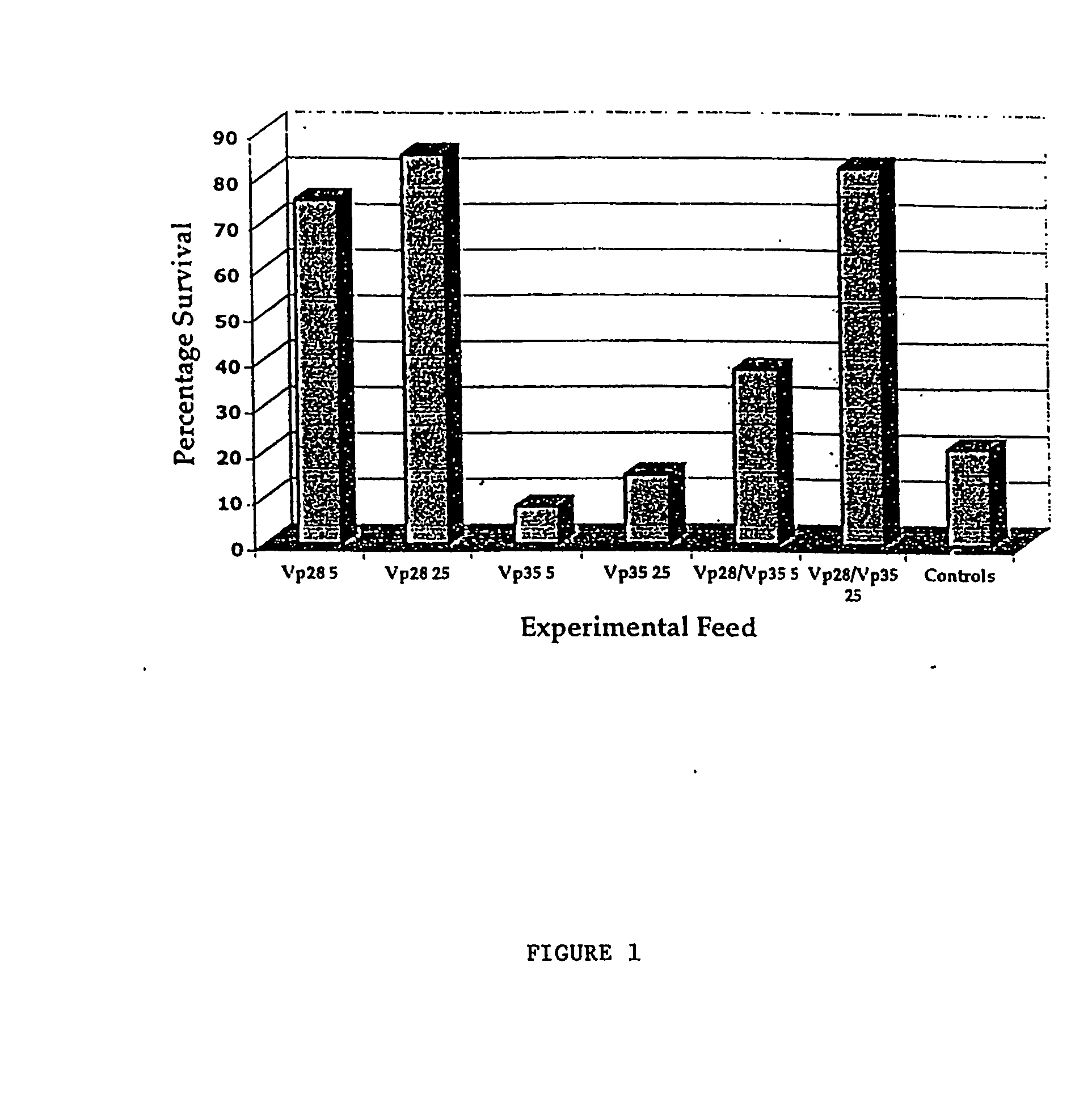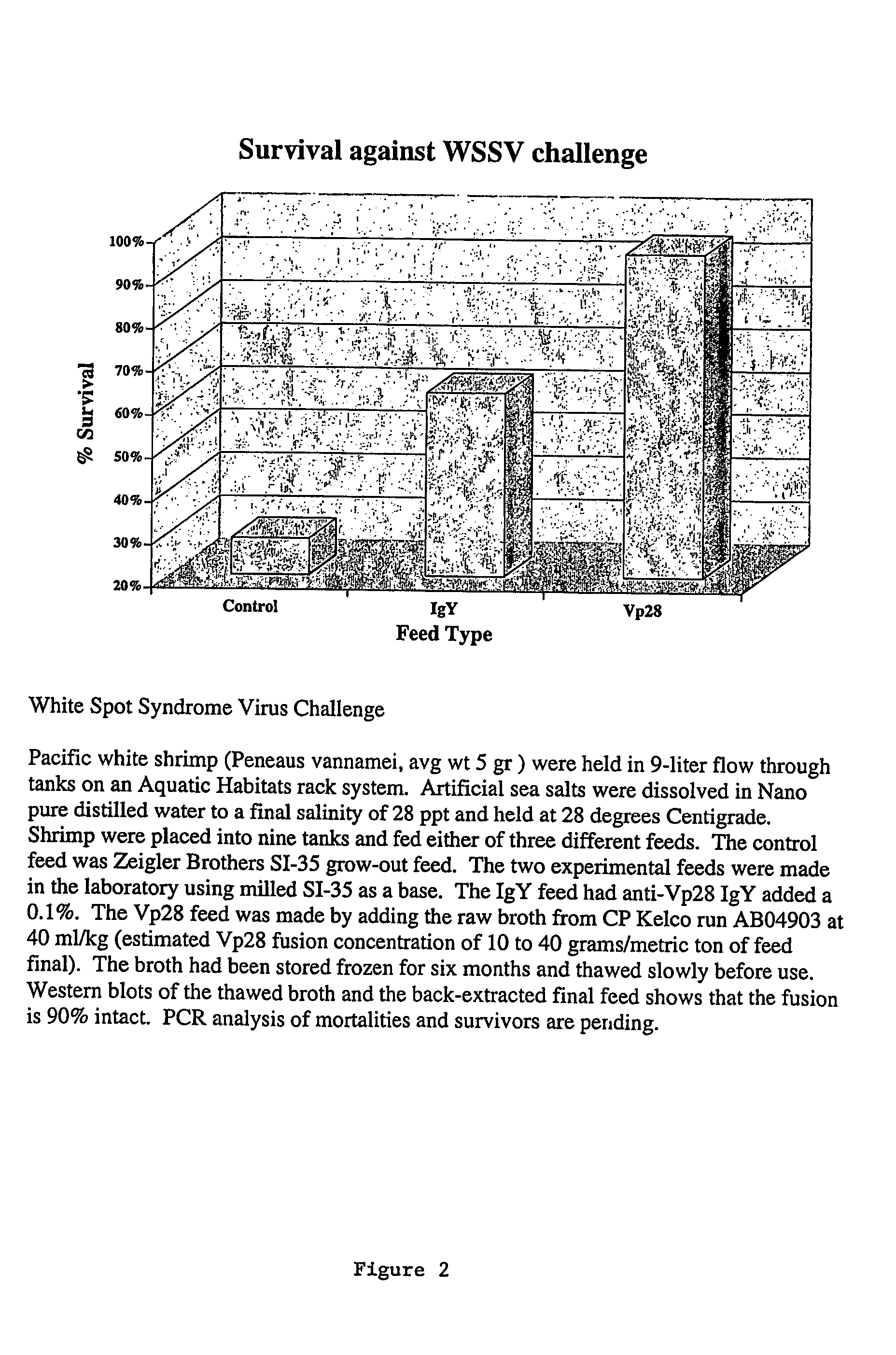Compositions and methods for inhibiting white spot syndrome virus (wssv) infection
a white spot syndrome virus and composition technology, applied in the field of shrimp aquaculture, can solve the problems of virus infectivity, large economic loss, prior art, etc., and achieve the effect of preventing or inhibiting wssv entry into the cell
- Summary
- Abstract
- Description
- Claims
- Application Information
AI Technical Summary
Benefits of technology
Problems solved by technology
Method used
Image
Examples
example 1
Expression of Viral Proteins and Protein Fragments
[0103] The four major nucleocapsid and envelope proteins from WSSV were evaluated. Each protein was modeled using the MacVector software package for primary and secondary structural motifs. Predictions based on the amino acid sequence of each protein were examined for secondary structural features using multiple predictive algorithms. The results from each of the predictive techniques were averaged and this information, along with additional predictive information on hydrophilicity, surface probability, flexibility, and antigenic index were used to select portions of each protein to be expressed in the fusion system. The portion of each viral protein that may potentially interact with a cellular receptor in the viral host is likely to be exposed on the surface of the protein. In addition, the interactive portion of each protein is likely to be contained on a single structural domain. By using the predictive information, likely porti...
example 2
Inhibition of WSSV Infection Using Vp28 Protein Fragments
[0106] Inhibition of WSSV infection using Vp28 fragments was performed as follows. A total of twelve 9-liter plastic aquaria (31 ppt salinity, 30° C.) are used to house the animals from the time they are received until the time the experiment is terminated. The tanks are distributed randomly between two separate rack systems, each with its own common water recirculation system. In addition to the test groups, two sentinel tanks and two positive control tanks are used to monitor the potential escape of the pathogen from the exposed tanks and to confirm the virulence of the virus, respectively.
[0107] Six experimental feeds were produced for use in the bioassay. Two viral fusion proteins, one containing a fragment of Vp28 and one containing a fragment of Vp35 were used alone or in combination at two different concentrations to prepare an extruded feed. Juvenile Penaeus vannamei were fed the experimental feed for 72 hours prior ...
example 3
White Spot Syndrome Virus Challenge
[0111] Pacific white shrimp (Peneaus vannamei, average weight 5 grams) were divided into groups and held in 9-liter flow through tanks on an Aquatic Habitats rack system. There were between 4 to 8 animals each tank, and 3 tanks in each group. Artificial sea salts were dissolved in Nano pure distilled water to a final salinity of 28 ppt and held at 28° C. Shrimp were placed in nine tanks and fed with one of three different feeds. The control feed was Zeigler Brothers SI-35 grow-out feed. The two experimental feeds were made in the laboratory using milled SI-35 as a base. The IgY feed had anti-Vp28 IgY added at 0.1%. The Vp28 feed was made by adding the raw both from CP Kelco run AB04903 at 40 ml / kg (estimated Vp28 fusion concentration of 10 to 40 grams / metric ton of feed final). In this experiment, the Vp28 fusion is a recombinant polypeptide of Vp28 fragment 1E (SEQ ID NO:4) fused with the surface array protein RsaA from Caulobacter cresentus prod...
PUM
| Property | Measurement | Unit |
|---|---|---|
| size | aaaaa | aaaaa |
| Tm | aaaaa | aaaaa |
| Tm | aaaaa | aaaaa |
Abstract
Description
Claims
Application Information
 Login to View More
Login to View More - R&D
- Intellectual Property
- Life Sciences
- Materials
- Tech Scout
- Unparalleled Data Quality
- Higher Quality Content
- 60% Fewer Hallucinations
Browse by: Latest US Patents, China's latest patents, Technical Efficacy Thesaurus, Application Domain, Technology Topic, Popular Technical Reports.
© 2025 PatSnap. All rights reserved.Legal|Privacy policy|Modern Slavery Act Transparency Statement|Sitemap|About US| Contact US: help@patsnap.com



